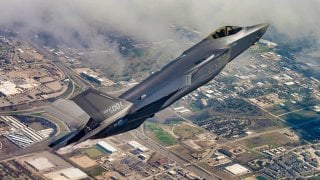The F-35 Has a Range Problem That China Would Love to Exploit
Despite its advanced fifth-generation capabilities, the F-35 Joint Strike Fighter is criticized for its limited range, particularly in expansive theaters of potential conflict like the Indo-Pacific.
Summary: The F-35 Joint Strike Fighter, despite its advanced fifth-generation capabilities, faces criticism for its limited range, particularly in the expansive theaters of potential conflict like the Indo-Pacific. The F-35A and F-35C variants, for the Air Force and Navy, respectively, are restricted to a 1,200-mile range, while the Marine Corps' F-35B variant has a mere 900-mile range. This limitation could complicate operations for Carrier Strike Groups and Marine Expeditionary Units, which might have to operate at or near the aircraft's maximum range. The F-35's limited range contrasts with the longer ranges of other aircraft like the F-22 Raptor and the F/A-18 Hornet, posing strategic challenges in maintaining operational flexibility and keeping launch platforms outside adversary detection zones.
Range Anxiety: How the F-35's Reach Could Shape Future Conflicts
The F-35 Joint Strike Fighter is celebrated for its fifth-generation capabilities. Yet, the futuristic jet is limited with respect to its range – which could pose a problem in a conflict that occurs within a wide-ranging theater, say the Indo-Pacific.
The F-35A (built for the Air Force) and the F-35C (built for the Navy) have ranges limited to just 1,200 miles. The F-35B (built for the Marine Corps and capable of VSTOL) is even worse, offering just 900 miles of range. By comparison, the F-22 Raptor boasts a 1,600-mile range; the F/A-18 Hornet boasts an 1,800-mile range. The relatively limited range of the F-35 could hamper operations involving Carrier Strike Groups and Marine Expeditionary Units when operating in the open ocean, vast theaters often forcing aircraft to operate at the threshold of their range.
While the early days of the F-35s development were over budget and behind schedule, the F-35 seems to have developed into a very reliable fifth-generation fighter, now in service with three US military branches. Today, the F-35 flies as it was designed to fly.
But the F-35 design, according to some critics, limits US military strategy. The problem in sum: the F-35’s range is too short.
“The A and C [F-35] variants, employed by the Air Force and Navy respectively, have ranges of 1,200nm while the B variant for Marine Corps can only manage 900nm,” Maya Carlin wrote for The National Interest. “By comparison, the F-22 Raptor can reach 1,600nm while the F/A-18 Super Hornet maxes at 1,800nm.” The comparison does not reflect well on the F-35.
Why the Range Issue Matters for the F-35
Range is crucially important for a Carrier Strike Group, or Marine Expeditionary Unit, operating in the open ocean. Although the F-35’s 1,200, or 900, mile nautical range may sound generous, bear in mind that the range must be budgeted to allow for flying to a target, engaging with the target (which is often fuel intensive) and returning from the target. The F-35 is capable of in-air refueling, but in contested airspace, in-air refueling may not be a feasible option.
The F-35's 1,200-mile range means that it must be launched from well within 600 miles of a target. This makes the vessel launching the F-35 increasingly vulnerable to detection and targeting from an adversary, who may limit the search scope based on the parameters of the F-35's range.
Drawing Navy and Marine Corps vessels closer to the shoreline brings those vessels closer to enemy defense systems. In a conflict with China, for example, the US would rely heavily upon their carrier and MEU fleets to provide airpower and control the airspace above wherever the conflict is being waged.
The F-35 would be a vital component of the conflict. However, the F-35s limited range increases the vulnerability of the vessels launching the F-35. One of the primary defense measures that large vessels have is that they are hard to find in the vast expanses of the open ocean.
The more constricted the search radius, the easier the vessel is to find. Given China’s stockpiling of intermediate and hypersonic missiles, agile surface vessels, and stealthy attack submarines, US vessels will want to avoid detection and tracking.
About the Author: Harrison Kass
Harrison Kass is a defense and national security writer with over 1,000 total pieces on issues involving global affairs. An attorney, pilot, guitarist, and minor pro hockey player, Harrison joined the US Air Force as a Pilot Trainee but was medically discharged. Harrison holds a BA from Lake Forest College, a JD from the University of Oregon, and an MA from New York University. Harrison listens to Dokken.


